How does the battery of Tesla's home storage battery 'Powerwall' deteriorate?

Analysis of Powerwall Battery Retention
https://www.netzero.energy/content/2025-02/powerwall-analysis
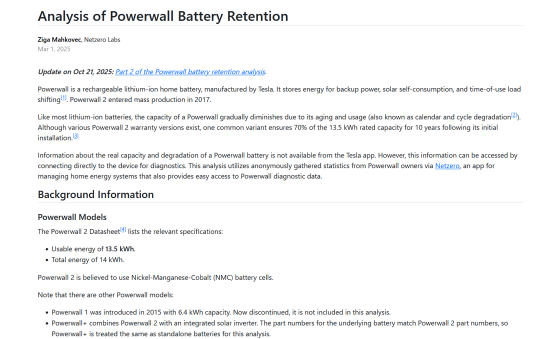
Powerwall is a rechargeable lithium-ion home battery developed by Tesla. Since 2017, 'Powerwall 2' has been in increased production, and in 2023, the next-generation version 'Powerwall 3' has been released. It has also been deployed in Japan and has been introduced at the GIGAZINE editorial department. In the article below, you can see what it looked like when the Powerwall was actually installed at the GIGAZINE editorial department.
I installed the home battery 'Powerwall' sold by Tesla. Report - GIGAZINE
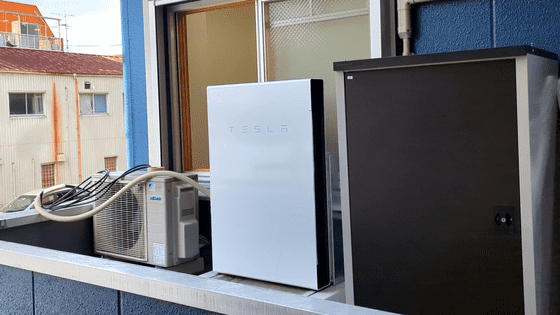
Like other lithium-ion batteries, Powerwall's capacity will gradually decrease over time with age and use. In general, Powerwall 2 is guaranteed to retain 70% of its rated 13.5kWh capacity for 10 years after initial installation.
Information about a Powerwall's actual battery capacity and degradation status is not available through Tesla's official app. However, Netzero for Powerwall provides access to this information by connecting directly to the device and running diagnostics. The development team published statistical data on battery degradation based on anonymous Powerwall battery data collected from users through Netzero for Powerwall. The data was collected through early 2025 and does not include the Powerwall 1, which began production in 2015.
The data that can be collected with Netzero for Powerwall is as follows:
The Powerwall's manufacturing date can be estimated from the battery serial number.
Part Number: This indicates the hardware revision of the Powerwall. There are over 30 different part numbers for the Powerwall 2, but the statistics break them down into broader groups.
Nominal Full Pack Energy: The battery management system's estimate of the current full capacity, reported in statistics in kWh.
Lifetime charging and charging energy: This is an indicator of battery utilization and is reported in kWh in the statistics. The analysis uses discharge data.
The analysis used data collected from 2,000 randomly selected Powerwall 2s. To prevent the identification of individual batteries, the researchers injected random noise into the measurements, but not enough to affect the conclusions.
The graph below shows the manufacturing date (older on the left, newer on the right) on the x-axis and the nominal full-pack energy (full battery capacity) on the y-axis. We can see that the initial capacity of the Powerwall 2 is higher than the nominal 13.5 kWh, and that it remains relatively stable after degradation over the first four years. Most Powerwall 2s are still within 90% of 13.5 kWh at seven years old. We also see a clear cluster of outliers with significant degradation from late 2018 through 2019.
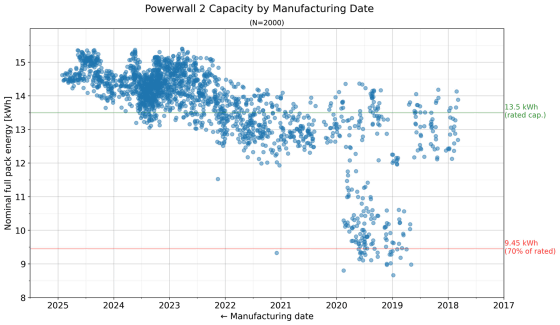
Below is a color-coded view of each part number. We were able to confirm that all of the outlier clusters from late 2018 through 2019 had part numbers beginning with '2012170.'

The graph below shows the manufacturing date on the X axis and the nominal full-pack energy on the Y axis, along with lifetime discharge energy as a color. The closer to purple the color, the lower the discharge energy, while the closer to yellow the higher the discharge energy. As the development team expected, the higher the discharge energy, the higher the degradation rate. For example, in the Powerwall 2 manufactured at the end of 2017, there is a capacity difference of approximately 2 kWh between units with low utilization and those with high utilization.
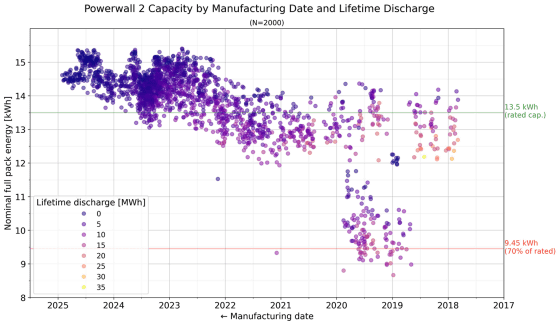
Discharge energy varies depending on the number of cycles and depth of discharge. For example, if you keep the battery nearly 100% charged in case of a power outage, the lifetime discharge energy will be low. However, if you use the battery nearly 100% every day for purposes such as self-consumption of solar power, the lifetime discharge energy will be high. The maximum discharge value in the sample set was approximately 35 MWh, which means that a Powerwall 2 with a nominal capacity of 13.5 kWh discharged at 100% depth of discharge was actually discharged for more than 2,590 cycles (equivalent to approximately 7 years).
The team also reported on the battery degradation of the Powerwall 3 in early 2025. The graph below shows the manufacturing date on the X axis and the nominal full-pack energy on the Y axis, with a sample size of 500 units. Overall, the Powerwall 3's initial capacity is slightly lower than the Powerwall 2, but the degradation rate appears to be modest.

The development team released Part 2, which included additional data, in October 2025, approximately eight months after releasing the above data.
Analysis of Powerwall Battery Retention - Part 2
The graph below shows the manufacturing date on the X axis, the nominal full-pack energy on the Y axis, and the part number on the color. The sample size has been increased to 4,000 units, and data collected since the previous report is included. The overall trend remains the same, and we can see that Powerwall 2 production ended around November 2024.

The graph below shows the battery capacity change over time for Powerwall 2 units with a history of at least six months. The early units (blue) show little degradation and remain stable over time. Some units have shown signs of battery capacity recovery, which may reflect temperature changes or the effects of
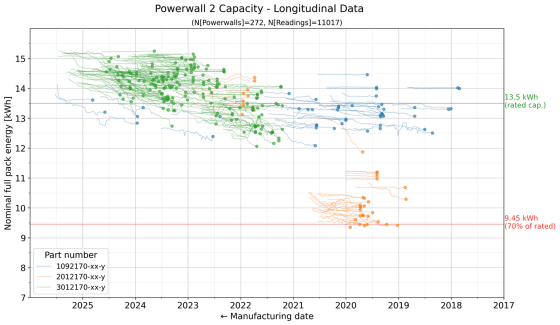
We also significantly expanded our data set for the Powerwall 3. Collecting data from a total sample of 4,000 units, we again see that the Powerwall 3 has a slightly lower initial capacity, but degrades more slowly over the first year after manufacturing.

Related Posts:
in Hardware, Posted by log1h_ik







